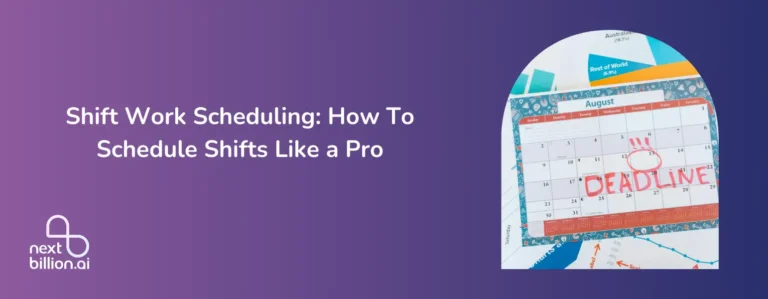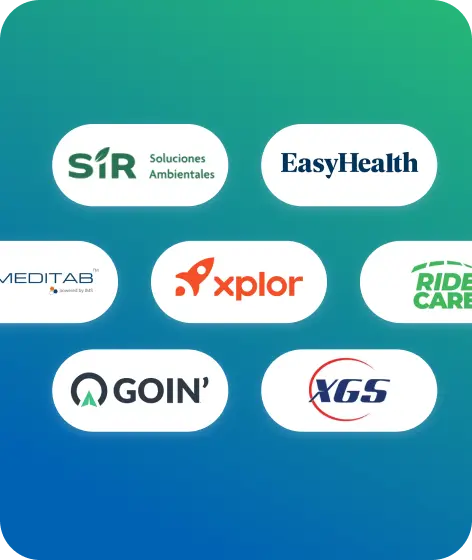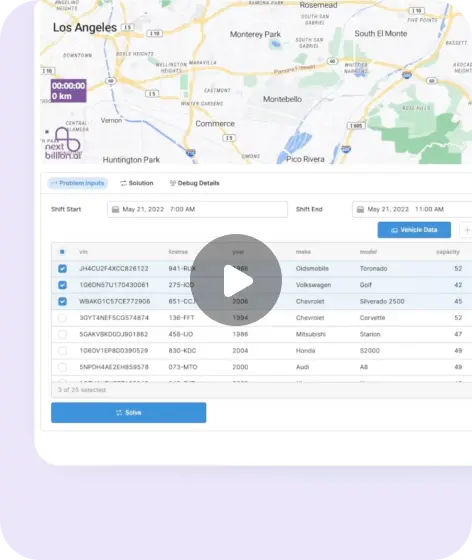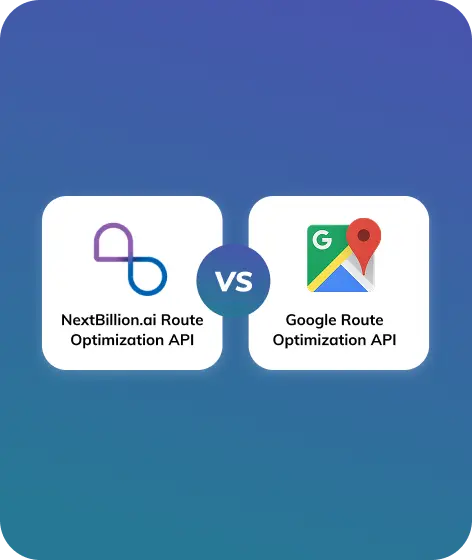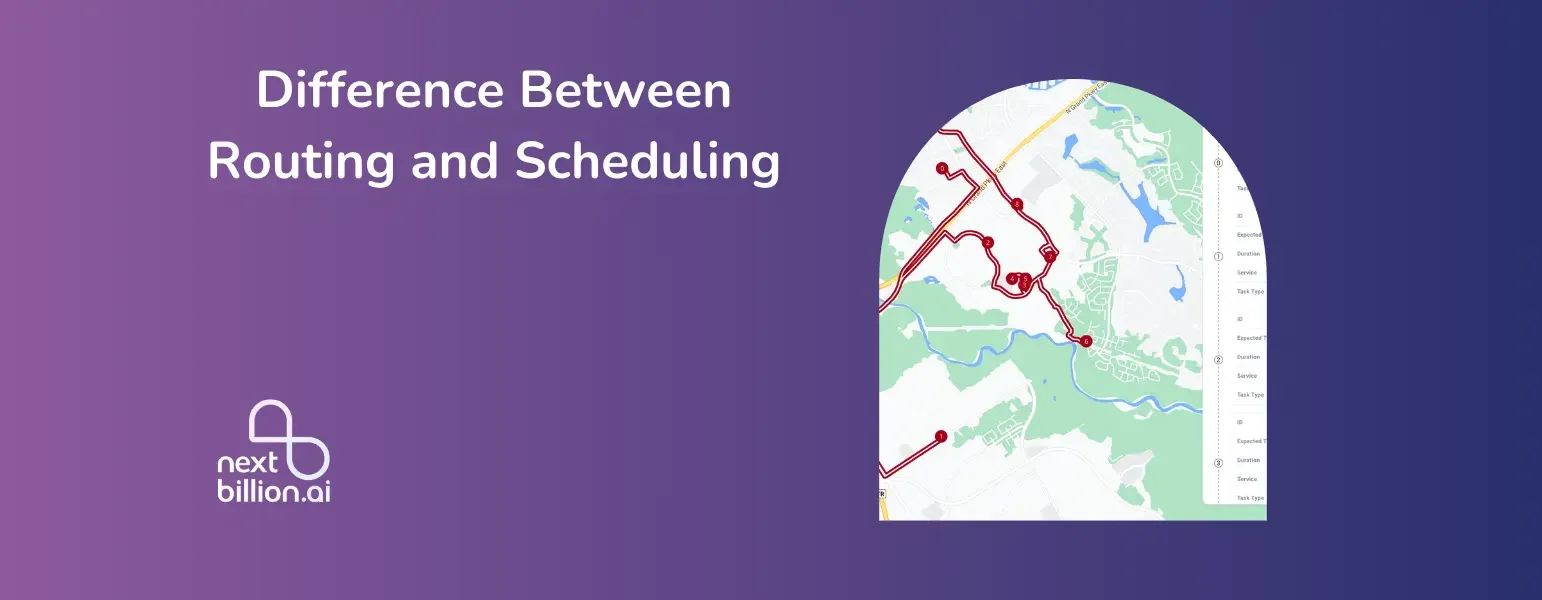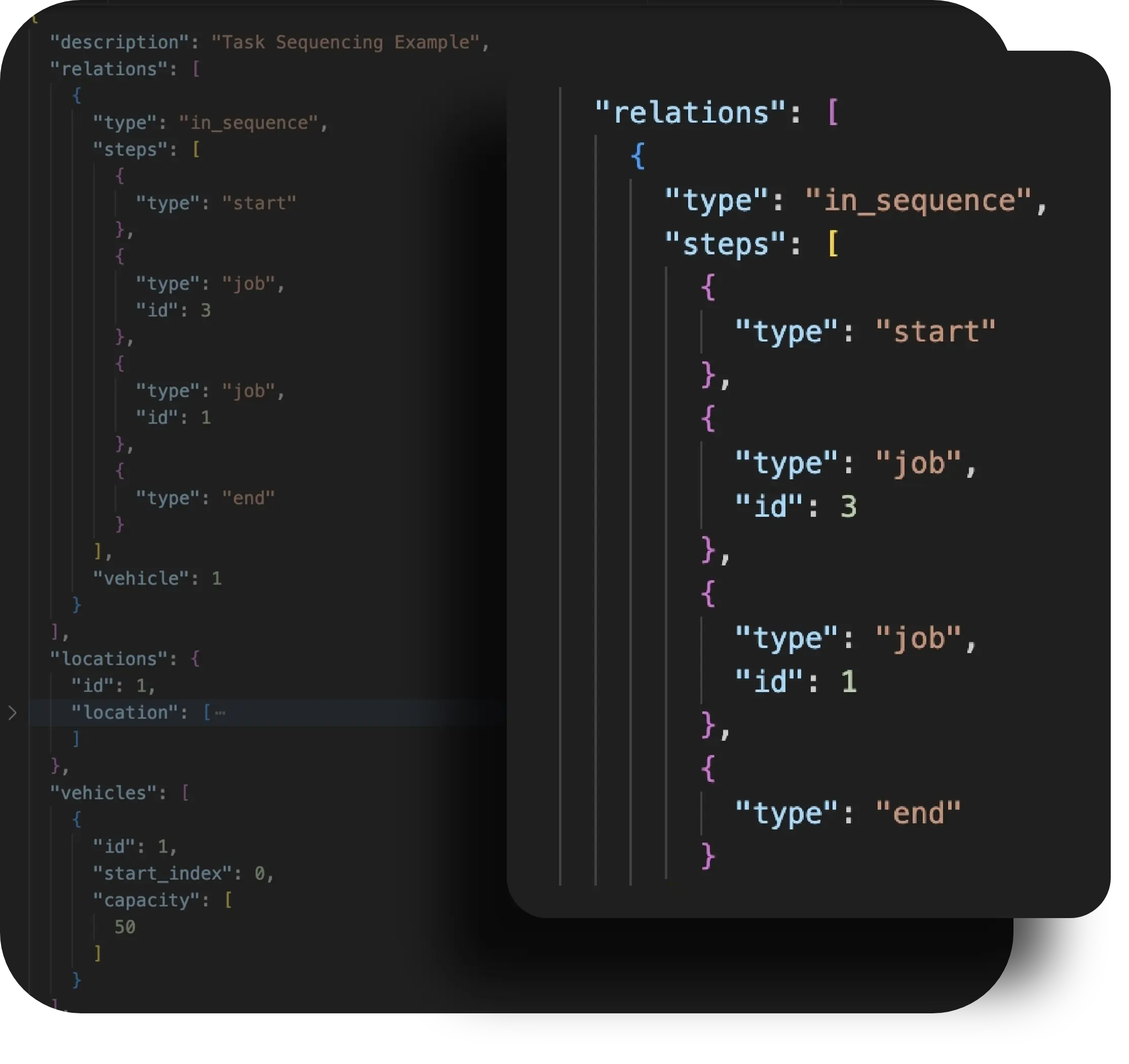
Table of Contents
Routing and scheduling are the heart and soul of logistics. The transportation and logistics industry relies heavily on advanced routing and scheduling methods to ensure seamless operational efficiency.
Did you know that according to a 360 Research Report, during COVID-19, the routing and scheduling market size was worth USD 2551.3 million in 2021. This number is all set to grow to USD 4576 million by 2028 with a Compound Annual Growth Rate (CAGR) of 8.6 Percent.
This goes on to show the sheer magnitude of this industry and its growth prospects in the future.
Routing and scheduling are essential for managers overseeing delivery operations or mobile service teams. While you may already be using tools to manage both, grasping the distinct benefits of routing and scheduling can significantly boost your effectiveness. This understanding can help you increase delivery or service capacity and substantial revenue growth for your business.
To understand the differences between routing and scheduling, let’s deep dive into what each of them entail.
What is Routing?
Routing is the process of mapping specific routes that drivers can take to deliver goods. These routes are calculated and assigned in a strategic way in order to address delivery requests quickly and efficiently.
Route planning transforms your schedule into precise, optimized paths for delivery drivers or service professionals. It considers factors such as vehicle capacity, travel time, and transportation costs to create the most efficient routes.
Routing focuses on finding the most efficient travel paths for delivery vehicles, from their starting point to various destinations. It determines the optimal order of stops and the specific routes vehicles should follow.
The key goals of routing are to minimize travel time, reduce distance covered, and lower fuel consumption. This process takes into account several factors, including road conditions, traffic patterns, vehicle capacities, and delivery time windows. By optimizing these elements, routing can streamline operations and improve overall delivery efficiency.
Key Features of Routing
Route optimization: This is the cornerstone of efficient logistics management. It involves finding the most effective path for delivery vehicles to make all the necessary stops in the best possible order. This process often depends on calculated algorithms that solve complex routing and delivery issues.
Algorithms are mathematical approaches that consider multiple factors simultaneously, including distance, time, fuel consumption, and the priority of different deliveries. Modern route optimization goes beyond static planning, incorporating dynamic rerouting capabilities that can reroute paths in real-time as conditions change. To handle the complexity of large-scale route planning for entire fleets, there are specialized solutions like Nextbillion’s Route Optimization API. These tools also integrate machine learning and artificial intelligence to predict optimal routes based on historical data and observed patterns, continually improving their recommendations over time.
As we know, the best and quickest routes to delivery save time, effort and cost, thereby elevating the business standards.
Traffic and road conditions: Overseeing and coordinating for traffic and road conditions is crucial for accurate and efficient route planning. This involves integrating real-time traffic data to get live information on traffic blocks or diversions across the delivery area. Route planning managers must also factor in information about ongoing or planned construction work, accidents, or other temporary road closures that could impact travel times.
Weather conditions, though predicted, are critical to routing. Any adverse conditions can significantly impact both travel times and road safety. Today, we have advanced systems like Nextbillion’s Route Optimization API that analyze historical traffic data to predict future conditions at different times of day or on different days of the week, for accurate long-term planning. With such meticulous data, you can provide drivers with alternative route suggestions in case of unexpected delays or closures during their journey.
Vehicle Load: This is another critical factor in route planning. It involves more than simply matching cargo volume to vehicle size and requires a deeper understanding of how to best utilize each vehicle’s capabilities. Load optimization ensures that each vehicle is filled to its ideal capacity without exceeding weight limits or compromising safety. Route planners must also consider the specific characteristics of each vehicle when assigning routes to ensure that the delivery is smooth. In some cases, efficient routing involves planning multi-trip routes where vehicles return to a depot for reloading during a shift. Balancing load weight with fuel consumption is key, as heavier loads can significantly impact fuel efficiency and overall operational costs.
What is Scheduling?
Scheduling is the process of planning delivery timings and assigning the drivers for the tasks. Scheduling focuses on optimizing workloads and managing the available workforce, taking into consideration other constraints such as customer’s time preference, delivery time windows, and driver shifts. The main objective of scheduling is to efficiently assign delivery orders to available time slots. This planning helps in seamless operation and customer satisfaction.
Key Features of Scheduling
Time Management: This is a crucial aspect of scheduling and involves assigning specific delivery timeframes based on customer preferences and operational constraints. This process requires balancing customer requirements with the logistical constraints of delivery. To manage time windows effectively, you need to consider factors such as peak traffic hours, delivery location accessibility, and the nature of the goods being delivered. It may involve offering customers a choice of delivery slots or working within pre-established timeframes. The goal is to create a schedule that satisfies customer expectations while maintaining operational efficiency. This often requires sophisticated algorithms that can juggle multiple time constraints simultaneously, ensuring that deliveries are planned in a way that minimizes travel time between stops while still meeting promised delivery windows.
Driver Shifts and Availability: As we know, any amount of automation still requires human intervention. As part of scheduling, the most important players are the drivers. Their shift timings, skills and capacity have to be considered prior to assigning a delivery task. All delivery routes must be designed to fit within the available work hours of delivery drivers. So, factors such as shift patterns, legally mandated break times, and maximum working hours are to be considered.
Effective route planning must also consider the wellbeing of the drivers, their fatigue levels and overall health, to ensure that routes are not only efficient but also sustainable from a human perspective. This process involves shuffling drivers in shifts or assigning different types of routes to provide a balanced workload. As routing does, scheduling also involves planning for unexpected events such as traffic delays or vehicle breakdowns, and building in appropriate buffer time.
Customer Delight: Like how all rivers lead to the sea, all services ultimately lead to customer satisfaction. That’s a reason why logistics companies increasingly try to accommodate individual preferences for delivery times within the bounds of feasibility. Customers are also given the choice of a range of delivery slots, specific delivery days or even time ranges.
However, this is a taxing process and must be planned to meet operational efficiency. The challenge lies in finding the balance between customer satisfaction and cost-effective processes. Some companies use incentives to encourage customers to choose delivery times that align well with existing routes, such as offering discounts for less popular time slots.
Order Grouping: This is another strategy used to maximize delivery efficiency by combining orders with similar delivery windows or locations. This allows delivery vehicles to make multiple stops in a single area, reducing overall travel time and fuel consumption. Effective order grouping requires in depth analysis of order data to identify patterns and opportunities for consolidation. It also involves adjusting expected delivery times (within acceptable limits) to create more efficient groupings. In certain cases, you may also need to coordinate with customers to match their delivery preferences with efficient route planning.
Economical Operations: By scheduling you can optimize delivery operations, resource utilization, reduce costs, improve customer satisfaction and enhance overall operational efficiency. One of the primary benefits is reduced operational cost.
When delivery vehicles ply the shortest and most efficient paths, route scheduling minimizes travel distance and fuel consumption. This not only leads to direct savings on fuel costs but also reduces labor costs by minimizing the time drivers spend on the road. Additionally, by reducing unnecessary mileage and vehicle wear and tear, effective route scheduling can significantly lower maintenance costs over time.
Time Management: Delivery consumes a lot of on-road time. It also includes wait time (if there are any roadblocks), weather conditions, and other unexpected situations. Route scheduling or optimizing routes, enable vehicles to reach their destinations faster, thereby reducing overall delivery time. Quicker deliveries always make customers happy and they would most likely choose your services over other providers. With advanced route scheduling tools like Nextbillion’s Route Optimization AI, you can even account for real-time traffic conditions, allowing for dynamic route adjustments that save additional time.
Delivery Capacity: Scheduling increases delivery capacity to its fullest. This ensures that vehicles are loaded to their maximum capacity and deliveries are planned for minimal backtracking. Managing delivery capacity leads to fewer trips for the same number of deliveries, further reducing costs and environmental impact. Strategically planned and sequenced deliveries contribute to smoother operations and can help in managing time-sensitive deliveries more efficiently.
How to Implement Advanced Routing and Scheduling in Your Business?
Optimizing routes and strategic scheduling processes are both complex and cumbersome. They require planning cost-effective routes while considering factors such as traffic conditions, weather patterns, construction zones, and other potential obstacles.
Manual route planning is an incredibly time-consuming task. Depending on the number of stops your drivers need to make, it can potentially take hours to complete. There’s also a risk factor involved with route calculation being done manually. There are chances of service professionals stuck in heavily congested areas or accidentally scheduling a visit at a time when the customer is unavailable.
Another challenge in delivery is when there is a last minute customer request for a change in drop-off location. Changing even a single stop can have a ripple effect on how you approach your other service visits. When planning routes manually, it becomes extremely difficult to switch out a stop and create a new cost-effective route from scratch. This limitation often leads to disappointing customers by having to deny their service requests.
These challenges underscore the importance of implementing effective route optimization tools. With Nextbillion’s comprehensive and robust Route optimization API, you can efficiently plan delivery routes in less than a minute, eliminating most issues that arise from manual planning.
Here’s your chance to change your business game and scale up your operations with this most-sought-after optimization API.
Nextbillion’s Route Optimization API

Nexbillion’s Route Optimization API offers a comprehensive solution for all logistics and transportation services. This versatile tool generates optimal routes to maximize vehicle utilization while accommodating your specific requirements. It incorporates over 50 hard and soft routing constraints and allows customization with functions such as shortest distance, lowest cost, or quickest estimated time of arrival.
The API is designed to optimize delivery routes and solve both Single and Multi-Vehicle Routing Problems (VRP). By efficiently allocating the best routes for vehicles to cover various locations, Nexbillion’s Route Optimization API adeptly handles a range of constraints including time windows, capacity limitations, and vehicle availability.
As an experienced API tool, this route optimization API provides all the features necessary for your logistics business and is capable of scaling up to more. This scalability makes the API a robust choice for any business that aims to streamline their route optimization processes.
Let’s explore the features that establish Nexbillion’s Route Optimization API as a preferred option across various industries.
Optimal Route Allocation
As we saw earlier in the article, both routing and scheduling need optimized processes to assure operational efficiency. Routing algorithms in Nextbillion’s route optimization API significantly enhance vehicle efficiency by integrating crucial factors such as real-time traffic data, vehicle capacity limits, time constraints, and zones to be avoided. This advanced system cleverly manages operations selecting logical routes with optimized task sequencing for delivery.
This API allocates precise routes for vehicles to deliver at various locations, eliminating unwanted or excessive mileage. This ensures timely deliveries while simultaneously reducing travel time, minimizing vehicle wear, and reducing fuel consumption. The outcome is a streamlined process that improves overall the delivery experience from start to finish.
Choosing optimized routes help you achieve greater efficiency, reduce costs, and enhance your ability to meet customer demands.
Real-Time Traffic Data
Nextbillion’s route optimization API provides real-time tracking options with which you can determine better routes and oversee all of your vehicles at one go.
It gives you in depth data on every activity at an operational level. You can monitor real-time information on vehicles across various locations to ensure that all deliveries are on track.
With this data you can track driver performance and provide instant route progress updates. Real-time information also helps you in making informed decisions and have better control over operations.
Strategic Task Sequencing
Scheduling is the best way to ensure organized delivery. It also helps in prioritizing and assigning tasks ahead in time. Product deliveries have surged over the past few years and it’s only going to increase by the day. Delivering products, big or small, bears a huge responsibility.
Route optimization API like Nextbillion’s API offer features with which you can schedule delivery tasks, considering distance, time, and driver effort. Task sequencing allows a driver to deliver goods at more than one location down the same travel route. So ideally, the driver can drop off products at more than one customer location without having to make several small trips back to the distribution center.
Task sequencing is a smart way to organize work, considering the maximum load the vehicle can hold, the driver’s capacity, and the driver’s bandwidth to accommodate several stops.
With this route optimization API, the tool automatically assigns deliveries based on all the live data it receives and analyses.
Useful Data Analytics
Nexbillion’s Route Optimization API provides a suite of comprehensive analytical tools and reporting features, that provides thorough monitoring of driver efficiency, route effectiveness, and delivery timing. These data-driven insights help you to continually refine your operations, resulting in improved performance and reduced costs. This analytical approach lays a good foundation for making critical decisions based on concrete data. The ability to track, analyze, and adjust based on real-time and historical data allows for a dynamic and responsive logistics strategy, ensuring that your operations remain efficient and cost-effective in the face of changing conditions and requirements.
The more the data, the better the nuances of operations. The API provides intrinsic useful data that eventually helps you scale your business and increase customer base.
Simple Driver Instructions
Nexbillion’s Route Optimization API significantly streamlines the complex tasks of driver dispatch and route management, especially when dealing with unexpected changes. It offers a simple driver dispatch feature that allows flexible route modifications on the fly. This tool sends precise driving directions and delivery instructions directly to drivers, ensuring clear communication and alignment across the entire team. Communication, like in all other aspects, needs to be crystal clear. Last mile deliveries are the deciding factors for customer retention as well as new customers.
By assisting the drivers with clear information, you can minimize confusion, improve responsiveness to changing conditions, and enhance overall operational efficiency in dynamic logistics environments. This route optimization API simplifies processes and helps in reducing errors, save time, and increase adaptability, which are all critical factors.
Easy On Your Pocket
While you get dispatch-ready routes with more than 50 constraints, customize request parameters, improvise routes on-the-go with real-time data and fulfill ad hoc orders with ease, Nextbillion’s route optimization API is the most-economical tool you can find in the market! You can choose your pricing model that works for your business instead of paying per API call.
This gives you the liberty to explore what works best for you. Not just that, with meticulous routing and scheduling, you can drastically bring down your fuel costs (which is the highest expense in logistics). Reduced costs equals to increased savings!
Quick Integration
Finding the right tool is one. But getting a tool that integrates perfectly with your existing system is mostly an elusive dream. Nextbillion’s route optimization API integrates perfectly with any logistics SaaS solutions and transport management systems, making it the number one choice for many companies.
Benefits of Optimized Routing and Scheduling
Optimized routing and scheduling has benefits that are critical for your business health. As per research, you can reduce your scheduling time by forty percent, save API costs by thirty percent and reduce operational costs by thirty five percent.
There’s more to deploying Nextbillion’s route optimization API. You can excel at last mile delivery by utilizing custom features exclusive for your business. From material handling to delivering on-time, this API hand holds you to seamless completion of tasks.
Implementing a route optimization API can have a lasting impact on your business, leading to increased revenue per driver and significant reductions in overall costs. This powerful tool transforms voluminous data, previously managed as documents, into simple, actionable information. By deciphering complex data into intelligible insights, the API enables you to make smarter decisions and drive continuous improvements. The streamlined approach to data management and analysis allows for more efficient operations, better resource allocation, and enhanced strategic planning. Ultimately,this leads to improved profitability, enhanced customer satisfaction, and a stronger competitive position in the market.
Let’s take a look at some concrete benefits that are bound to help your business grow:
Increased Productivity: The most valuable benefits of implementing a route optimization tool are to save time and money. By scheduling routes ahead in time and adopting faster routes for delivery, you can save fuel costs to a large extent. This translates to increased productivity and improved ROI.
Task allocation, driver assignments and routing using live data, get better with the API. And did you know that happier employees result in a healthier work environment, and thus ensures customer delight?
Route optimization API is a wholesome package that you should use to scale your business to greater heights.
Happy Customers: Nextbillion’s route optimization API helps your company track data in real-time, measure estimated time of arrival (ETA) and communicate instantly with the drivers for deliveries. Pristine communication and calculated scheduling makes sure that you can assign the best drivers for the routes planned and also make quicker deliveries.
The best way to gain more customers as well as retain existing customers is to offer them services that they remember. Quicker delivery is always something that everyone remembers and this is one of the most important reasons for people to become returning customers.
No Hassle Assignments: With lesser human intervention and optimized routing and scheduling, there’s little or no scope for errors. This is a boon to companies that rely on large fleets for delivery. Forecasted scheduling prepares you for upcoming workload and prepares the drivers for their line of tasks. Similarly, optimal routing gives the drivers a clear understanding of the distances to be covered and the time taken to do it.
Live updates and historical data help in hassle-free operations and seamless completion of delivery assignments.
Why Should You Choose Nextbillion’s Route Optimization API?
The differences between routing and scheduling may be a few, but the line that connects them to perform better is definitely a tool like Nextbillion’s route optimization API. After careful consideration of all the benefits that this API offers, there’s no doubt that this tool could give you the next big break for your company.
Move ahead of your competitors, scale higher and win more customers with Nextbillion’s revolutionary route optimization API!
About Author
Rishabh Singh
Rishabh Singh is a Freelance Technical Writer at NextBillion.ai. He specializes in Programming, Data analytics and technical consulting, turning complex tech into clear and engaging content.
Ready to get started?
Table of Contents
Related Posts

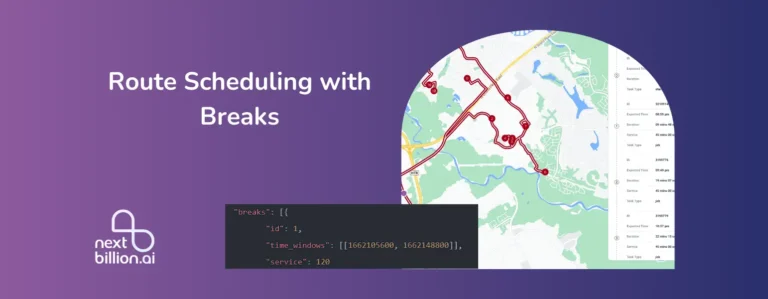
Route Scheduling with Breaks
